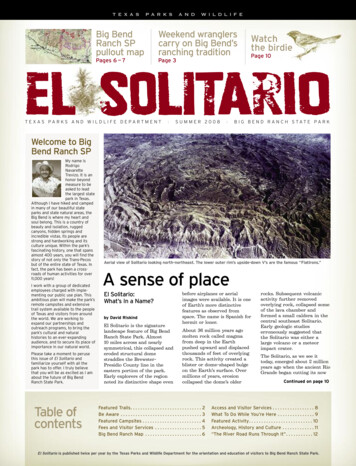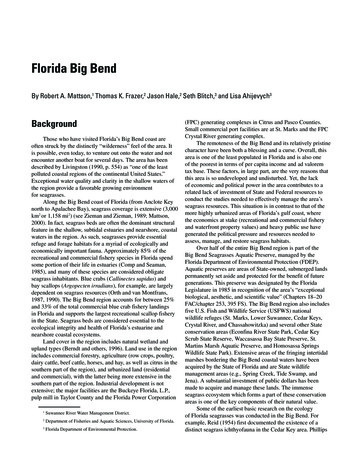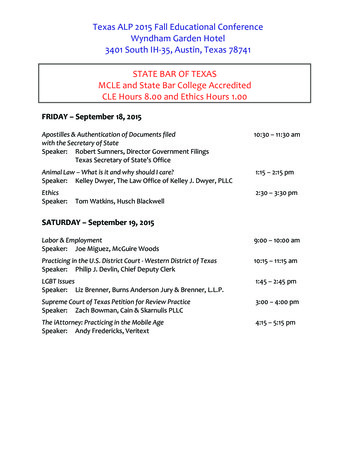
Transcription
Field Guides Tour ReportTexas' Big Bend & Hill Country 2016Apr 23, 2016 to May 2, 2016Chris Benesh & Cory GregoryFor our tour description, itinerary, past triplists, dates, fees, and more, please VISIT OUR TOUR PAGE.A few scenes from Texas: the Mule Ears formation and Boot Canyon from Big Bend National Park and, at right, sunset at the Frio Bat Cave near Concan. (Photos byguide Chris Benesh)The 2016 Big Bend and Texas Hill Country tour got off to a bit of a rocky start thanks to some unforeseen circumstances at the San Antonio Airport onthe first afternoon. But we did eventually make our way to Del Rio. Our following morning there was terrific, with a nice assortment of speciesincluding Ringed and Green kingfishers, White-collared Seedeater, Olive Sparrow, Great Kiskadee, Couch's Kingbird, Long-billed Thrasher, andYellow-breasted Chat. We then headed westward, crossing the Pecos River and paying a visit to Langtry before continuing on to Big Bend NationalPark.Our first morning at Big Bend saw us visiting Blue Creek Canyon where we were able to track down our first Varied Buntings, Gray Vireo, and at leastthree different Lucifer Hummingbirds. An Olive-sided Flycatcher was also there. Another Olive-sided was a highlight of our afternoon visit to DugoutWells. But not before we were able to get nice views of a pair of Black-capped Vireos. A pair of Yellow-headed Blackbirds added a splash of color to theDugout Wells experience.Our second morning in Big Bend saw us visiting Rio Grande Village. The birding was good with cooperative nesting Common Black Hawks and GrayHawks, along with a some nice views of a variety of migrants and breeders. Vermilion Flycatchers were everywhere. There was a migrant Cassin'sKingbird and Cassin's Vireo, along with a Plumbeous Vireo there. There were also three species of bunting (four if you throw in Blue Grosbeak, whichis an oversized bunting). A few Clay-colored Sparrows were mixed in with the Chippings. In the afternoon we made a walk around the basin grounds,and got quick looks at Black-chinned Sparrows, Black-crested Titmouse, and some black-eared Bushtits.The third morning was the big hike into the high country of the Chisos to Boot Springs in search of the Colima Warbler. Our route was up the PinnaclesTrail. At around the three mile mark, we came upon our first Colima. The bird was really cooperative and sat for us while we all had looks and tookpictures. A few turned back at this point, while most of us continued on to Boot Springs. The springs were active; several more Colimas, PaintedRedstarts, Cordilleran Flycatchers, and a heard-only Dusky-capped Flycatcher were of note. A Western Tanager en route was a local rarity. Bluethroated and Broad-tailed hummingbirds were also present.Our final morning featured a visit to Cottonwood Campground. There was a bit of activity there, and we had a nice Great Horned Owl, a rare BrownThrasher, a glimpse of Bullock's Oriole, and some Inca Doves among the more common species. We then headed back to the lodge to pack up and headto Alpine. We made a couple of stops for Chihuahuan Raven and Lilian's Meadowlark en route. The rest of the afternoon was spent searching forMontezuma Quail. We managed to hear a male and female calling on the hillside in front of us, but they did not materialize. Once again a beautiful nightsky.Our morning in the Davis Mountains began with some more searching for quail and was rewarded with three or four birds standing near the road at thepark. We then headed to Lake Balmorhea, where we saw lots of Clark's Grebes and White-faced Ibis, a handsome Snowy Plover, and a rare Whimbrel,among others. We could hear Brewer's Sparrows churring in the distance there and had a male Lark Bunting in full breeding plumage. And then wemade the long drive to the Edwards Plateau and Concan.After a tremendous overnight thunderstorm, we headed north to Lost Maples SNA, where was took in a variety of songs, mixing birds from the east,west, and south. We had a couple of nice looks at Golden-cheeked Warbler, Yellow-throated Warbler, and an amazing Louisiana Waterthrush that flew inand began to sing right in front of us. Acadian Flycatchers were nice, too. It was interesting to see and hear south Texas birds like Olive Sparrow, GreatKiskadee, and White-tipped Dove establishing themselves there. In the afternoon, we birded around the Neal's Lodges area, where the highlight was thestriking male Tropical Parula. Wow!Our final morning we spent on Highway 344 between Uvalde and Bracketville. This amazing road gave us our best looks yet of Gray Vireo and severalnew sparrows. Singing Bobwhite were a real treat too. From there, we headed to Fort Clark Springs, where we eventually came across some Green Jays,Field Guides Birding Tours www.fieldguides.com 800-728-49531
along with Black-throated Green Warbler and Blue-headed Vireo. That afternoon we headed out to the Frio Bat Cave for an amazing evening with theBrazilian Freetail Bats and a yummy meal that Sharon Mackie and Caroline Lewis from the Field Guides Austin office brought out for us. We wrappedthings up with a nice Eastern Screech-Owl on our way out of the cave property.--ChrisKEYS FOR THIS LISTOne of the following keys may be shown in brackets for individual species as appropriate: * heard only, I introduced, E endemic, N nesting, a austral migrant, b boreal migrantBIRDSAnatidae (Ducks, Geese, and Waterfowl)BLACK BELLIED WHISTLING DUCK (Dendrocygna autumnalis) – Seen in Del Rio and again near Uvalde.WOOD DUCK (Aix sponsa) – A couple of birds flew past the patio deck at Neal's Lodges.GADWALL (Anas strepera)AMERICAN WIGEON (Anas americana)MALLARD (NORTHERN) (Anas platyrhynchos platyrhynchos) – Really these consisted of mostly park ducks showing features of green headedbirds.MALLARD (MEXICAN) (Anas platyrhynchos diazi)BLUE WINGED TEAL (Anas discors)NORTHERN SHOVELER (Anas clypeata)LESSER SCAUP (Aythya affinis)RUDDY DUCK (Oxyura jamaicensis)Odontophoridae (New World Quail)SCALED QUAIL (Callipepla squamata) – Several sightings in Big Bend NP.NORTHERN BOBWHITE (Colinus virginianus) – We had at least four of these on RT344.MONTEZUMA QUAIL (Cyrtonyx montezumae) – A brief encounter with at least three males in the Davis Mountains.Phasianidae (Pheasants, Grouse, and Allies)WILD TURKEY (Meleagris gallopavo)Podicipedidae (Grebes)PIED BILLED GREBE (Podilymbus podiceps) – Two of these were at the Duck Pond in Del Rio.EARED GREBE (Podiceps nigricollis)WESTERN GREBE (Aechmophorus occidentalis)CLARK'S GREBE (Aechmophorus clarkii) – Some good studies of this species at Lake Balmorhea.Phalacrocoracidae (Cormorants and Shags)NEOTROPIC CORMORANT (Phalacrocorax brasilianus) – One at Duck Pond in Del Rio.Ardeidae (Herons, Egrets, and Bitterns)GREAT BLUE HERON (Ardea herodias)GREAT EGRET (Ardea alba)SNOWY EGRET (Egretta thula)CATTLE EGRET (Bubulcus ibis) – Three out of place birds in the desert at Big Bend NP.GREEN HERON (Butorides virescens)Threskiornithidae (Ibises and Spoonbills)WHITE FACED IBIS (Plegadis chihi)Cathartidae (New World Vultures)BLACK VULTURE (Coragyps atratus)TURKEY VULTURE (Cathartes aura)Pandionidae (Osprey)OSPREY (Pandion haliaetus)Accipitridae (Hawks, Eagles, and Kites)GOLDEN EAGLE (Aquila chrysaetos) – One at Lake Balmorhea was a nice surprise!SHARP SHINNED HAWK (Accipiter striatus)COOPER'S HAWK (Accipiter cooperii)COMMON BLACK HAWK (Buteogallus anthracinus) – Great looks at the nesting pair at Rio Grande Village.HARRIS'S HAWK (Parabuteo unicinctus) – Seen on the drive out to Del Rio and again on our last full day.GRAY HAWK (Buteo plagiatus) – We had a pair of birds at Rio Grande Village where they have been nesting for years.RED SHOULDERED HAWK (Buteo lineatus)BROAD WINGED HAWK (Buteo platypterus) – One was seen at Lost Maples where they may be rare breeders.Field Guides Birding Tours www.fieldguides.com 800-728-49532
SWAINSON'S HAWK (Buteo swainsoni)ZONE TAILED HAWK (Buteo albonotatus) – A couple of sightings in Big Bend NP, but our best views were at Davis Mountains State Park.RED TAILED HAWK (Buteo jamaicensis) – Most impressive were the hawks hunting bats on our final evening.Rallidae (Rails, Gallinules, and Coots)COMMON GALLINULE (Gallinula galeata) – One seen briefly in Del Rio.AMERICAN COOT (Fulica americana)Recurvirostridae (Stilts and Avocets)BLACK NECKED STILT (Himantopus mexicanus)AMERICAN AVOCET (Recurvirostra americana)Charadriidae (Plovers and Lapwings)SNOWY PLOVER (Charadrius nivosus) – We managed to find one along the shore at Lake Balmorhea.KILLDEER (Charadrius vociferus)Scolopacidae (Sandpipers and Allies)SPOTTED SANDPIPER (Actitis macularius)LESSER YELLOWLEGS (Tringa flavipes)UPLAND SANDPIPER (Bartramia longicauda)WHIMBREL (AMERICAN) (Numenius phaeopus hudsonicus) – Somewhat of a rarity in the interior, we had a single bird at Lake Balmorhea.LEAST SANDPIPER (Calidris minutilla)LONG BILLED DOWITCHER (Limnodromus scolopaceus)WILSON'S SNIPE (Gallinago delicata)Laridae (Gulls, Terns, and Skimmers)RING BILLED GULL (Larus delawarensis)Columbidae (Pigeons and Doves)ROCK PIGEON (Columba livia) [I]EURASIAN COLLARED DOVE (Streptopelia decaocto) [I]INCA DOVE (Columbina inca)COMMON GROUND DOVE (Columbina passerina)WHITE TIPPED DOVE (WHITE TIPPED) (Leptotila verreauxi angelica) – Heard at Lost Maples where this species has recently colonized. [*]WHITE WINGED DOVE (Zenaida asiatica)MOURNING DOVE (Zenaida macroura)Cuculidae (Cuckoos)YELLOW BILLED CUCKOO (Coccyzus americanus) – We encountered three individuals in the Hill Country.GREATER ROADRUNNER (Geococcyx californianus)Strigidae (Owls)EASTERN SCREECH OWL (Megascops asio) – Seen on our way out of the bat cave.GREAT HORNED OWL (Bubo virginianus)ELF OWL (Micrathene whitneyi) – We were lucky to find one at a day roost in Rio Grande Village.BURROWING OWL (WESTERN) (Athene cunicularia hypugaea) – This was a lucky find on our way to Balmorhea. This species has really declinedin west Texas.Caprimulgidae (Nightjars and Allies)LESSER NIGHTHAWK (Chordeiles acutipennis)COMMON NIGHTHAWK (Chordeiles minor)COMMON POORWILL (Phalaenoptilus nuttallii)CHUCK WILL'S WIDOW (Antrostomus carolinensis) [*]Apodidae (Swifts)CHIMNEY SWIFT (Chaetura pelagica)WHITE THROATED SWIFT (Aeronautes saxatalis)Trochilidae (Hummingbirds)BLUE THROATED HUMMINGBIRD (Lampornis clemenciae) – Well seen in Boot Spring.LUCIFER HUMMINGBIRD (Calothorax lucifer) – We had terrific looks at a couple of males in Blue Creek Canyon.BLACK CHINNED HUMMINGBIRD (Archilochus alexandri)BROAD TAILED HUMMINGBIRD (Selasphorus platycercus) – Up high in the Chisos.Alcedinidae (Kingfishers)RINGED KINGFISHER (Megaceryle torquata) – We had a high flyover in Del Rio and one perched over the Nueces River.GREEN KINGFISHER (Chloroceryle americana) – Good looks at the Duck Pond in Del RIo.Picidae (Woodpeckers)ACORN WOODPECKER (Melanerpes formicivorus)GOLDEN FRONTED WOODPECKER (Melanerpes aurifrons)Field Guides Birding Tours www.fieldguides.com 800-728-49533
LADDER BACKED WOODPECKER (Picoides scalaris)Falconidae (Falcons and Caracaras)CRESTED CARACARA (Caracara cheriway) – We saw one on our way west near Uvalde, and as many as five more on our last full day.AMERICAN KESTREL (Falco sparverius)PEREGRINE FALCON (Falco peregrinus) – A couple of folks saw this species near Uvalde.Tyrannidae (Tyrant Flycatchers)OLIVE SIDED FLYCATCHER (Contopus cooperi) – Three nice studies of this species in Big Bend.WESTERN WOOD PEWEE (Contopus sordidulus) – In the Davis Mountains and Lake Balmorhea.EASTERN WOOD PEWEE (Contopus virens) – A couple of these at Fort Clark Springs.ACADIAN FLYCATCHER (Empidonax virescens) – Great looks at this robust empid at Lost Maples.LEAST FLYCATCHER (Empidonax minimus) – One heard in the Hill Country. [*]DUSKY FLYCATCHER (Empidonax oberholseri) – One seen briefly on the hike up to Boot Spring.CORDILLERAN FLYCATCHER (Empidonax occidentalis) – Some nice views of this species at Boot Spring.BLACK PHOEBE (Sayornis nigricans)EASTERN PHOEBE (Sayornis phoebe)SAY'S PHOEBE (Sayornis saya)VERMILION FLYCATCHER (Pyrocephalus rubinus)DUSKY CAPPED FLYCATCHER (Myiarchus tuberculifer) – One called overhead while we were at Boot Spring, though we couldn't get a visual. [*]ASH THROATED FLYCATCHER (Myiarchus cinerascens)BROWN CRESTED FLYCATCHER (Myiarchus tyrannulus)GREAT KISKADEE (Pitangus sulphuratus) – In Del Rio, Fort Clark Springs, and also at Lost Maples where a recent colonist.COUCH'S KINGBIRD (Tyrannus couchii) – In Del Rio and again at Fort Clark Springs.CASSIN'S KINGBIRD (Tyrannus vociferans)WESTERN KINGBIRD (Tyrannus verticalis)EASTERN KINGBIRD (Tyrannus tyrannus)SCISSOR TAILED FLYCATCHER (Tyrannus forficatus) – What an amazing flycatcher!Laniidae (Shrikes)LOGGERHEAD SHRIKE (Lanius ludovicianus)Vireonidae (Vireos, Shrike Babblers, and Erpornis)WHITE EYED VIREO (Vireo griseus)BELL'S VIREO (Vireo bellii)BLACK CAPPED VIREO (Vireo atricapilla) – Nice views of a singing bird in the Chisos basin.GRAY VIREO (Vireo vicinior) – Terrific looks at this species in the Hill Country on Rt 334 as well as in Blue Creek Canyon.YELLOW THROATED VIREO (Vireo flavifrons) – A Hill Country bird.PLUMBEOUS VIREO (Vireo plumbeus)CASSIN'S VIREO (Vireo cassinii) – Nice studies of this and the next species at Rio Grande Village.BLUE HEADED VIREO (Vireo solitarius)HUTTON'S VIREO (Vireo huttoni)RED EYED VIREO (Vireo olivaceus)Corvidae (Crows, Jays, and Magpies)GREEN JAY (Cyanocorax yncas) – We tracked down a couple of these at Fort Clark Springs.WESTERN SCRUB JAY (WOODHOUSE'S) (Aphelocoma californica woodhouseii) – Since the completion of our tour, Western Scrub Jay has beensplit into two species. We saw Woodhouse's Scrub Jay both in the Davis Mountains (woodhouseii) and in the Hill Country at Lost Maples (texana).MEXICAN JAY (COUCH'S) (Aphelocoma wollweberi couchii)CHIHUAHUAN RAVEN (Corvus cryptoleucus)COMMON RAVEN (Corvus corax)Hirundinidae (Swallows)NORTHERN ROUGH WINGED SWALLOW (Stelgidopteryx serripennis)PURPLE MARTIN (Progne subis)BANK SWALLOW (Riparia riparia)BARN SWALLOW (Hirundo rustica)CLIFF SWALLOW (Petrochelidon pyrrhonota)CAVE SWALLOW (Petrochelidon fulva)Paridae (Tits, Chickadees, and Titmice)CAROLINA CHICKADEE (Poecile carolinensis)BLACK CRESTED TITMOUSE (Baeolophus atricristatus)Remizidae (Penduline Tits)VERDIN (Auriparus flaviceps)Aegithalidae (Long tailed Tits)Field Guides Birding Tours www.fieldguides.com 800-728-49534
BUSHTIT (Psaltriparus minimus)Sittidae (Nuthatches)WHITE BREASTED NUTHATCH (Sitta carolinensis)Troglodytidae (Wrens)ROCK WREN (Salpinctes obsoletus)CANYON WREN (Catherpes mexicanus) – Always a treat to see this species with its cascading song in the canyon lands.HOUSE WREN (Troglodytes aedon)CAROLINA WREN (Thryothorus ludovicianus)BEWICK'S WREN (Thryomanes bewickii)CACTUS WREN (Campylorhynchus brunneicapillus)Polioptilidae (Gnatcatchers)BLUE GRAY GNATCATCHER (Polioptila caerulea)BLACK TAILED GNATCATCHER (Polioptila melanura)Regulidae (Kinglets)RUBY CROWNED KINGLET (Regulus calendula) – A couple seen along the Pinnacles Trail.Turdidae (Thrushes and Allies)EASTERN BLUEBIRD (Sialia sialis) – We connected with a couple of these at Fort Clark Springs.HERMIT THRUSH (Catharus guttatus)Mimidae (Mockingbirds and Thrashers)CURVE BILLED THRASHER (Toxostoma curvirostre)BROWN THRASHER (Toxostoma rufum) – One was present at Cottonwood Campground in BBNP. This species is scarce this far west.LONG BILLED THRASHER (Toxostoma longirostre) – Seen in Del Rio and again at Fort Clark Springs.CRISSAL THRASHER (Toxostoma crissale) [*]NORTHERN MOCKINGBIRD (Mimus polyglottos)Sturnidae (Starlings)EUROPEAN STARLING (Sturnus vulgaris) [I]Motacillidae (Wagtails and Pipits)AMERICAN PIPIT (Anthus rubescens)Bombycillidae (Waxwings)CEDAR WAXWING (Bombycilla cedrorum) – It was a good year for waxwings with a number of sightings.Ptiliogonatidae (Silky flycatchers)PHAINOPEPLA (Phainopepla nitens) – We had a couple of these in the Davis Mountains SP.Parulidae (New World Warblers)LOUISIANA WATERTHRUSH (Parkesia motacilla) – An amazing show at Lost Maples where one perched up and sang out in the open in front ofus.BLACK AND WHITE WARBLER (Mniotilta varia)COLIMA WARBLER (Oreothlypis crissalis) – This species is generally speaking the most sought after one on a Big Bend tour. We were fortunate tohave several wonderful encounters with this species along the Pinnacles Trail and again at Boot Spring.NASHVILLE WARBLER (Oreothlypis ruficapilla) – A couple of these were seen at Neals and Fort Clark Springs.COMMON YELLOWTHROAT (Geothlypis trichas)TROPICAL PARULA (NORTHEAST MEXICO) (Setophaga pitiayumi nigrilora) – Another real treat of the trip was this singing bird right on thegrounds at Neals.YELLOW WARBLER (Setophaga petechia)YELLOW RUMPED WARBLER (AUDUBON'S) (Setophaga coronata auduboni)YELLOW THROATED WARBLER (Setophaga dominica) – One of the treats of birding in the Hill Country is the sweet sound of singing Yellow throated Warblers.TOWNSEND'S WARBLER (Setophaga townsendi) – Denise spotted one on our Pinnacles hike in Big Bend.GOLDEN CHEEKED WARBLER (Setophaga chrysoparia) – Lost Maples gave us some good viewing opportunities. Another highly sought afterspecies.BLACK THROATED GREEN WARBLER (Setophaga virens) – A single bird at Fort Clark Springs.WILSON'S WARBLER (Cardellina pusilla)PAINTED REDSTART (Myioborus pictus) – While more common in Arizona, the Chisos Mountains are home to this species too. We saw one on ourhike up to Boot Spring.YELLOW BREASTED CHAT (Icteria virens) – Del Rio has got to be the best place on Earth to see this species well. We had so many nice studiesthere.Thraupidae (Tanagers and Allies)WHITE COLLARED SEEDEATER (WHITE COLLARED) (Sporophila torqueola sharpei) – Del Rio has recently become a pretty good place tofind this scarce species too. We had nice looks at a male there.Emberizidae (Buntings and New World Sparrows)Field Guides Birding Tours www.fieldguides.com 800-728-49535
CASSIN'S SPARROW (Peucaea cassinii) – Perhaps more memorable for its song than its appearance.GRASSHOPPER SPARROW (Ammodramus savannarum) – We had one along route 334 in the Hill Country.OLIVE SPARROW (Arremonops rufivirgatus) – Another Rio Grande Valley specialty that gets to Del Rio and the Hill Country.CHIPPING SPARROW (Spizella passerina)CLAY COLORED SPARROW (Spizella pallida)BLACK CHINNED SPARROW (Spizella atrogularis) – After some work, we managed to track down one near the Chisos Lodge.FIELD SPARROW (Spizella pusilla)BREWER'S SPARROW (Spizella breweri)BLACK THROATED SPARROW (Amphispiza bilineata) – This is one of the sharper looking sparrows.LARK SPARROW (Chondestes grammacus)LARK BUNTING (Calamospiza melanocorys) – A nice flock seen on our way to Big Bend and a handsome male at Lake Balmorhea.DARK EYED JUNCO (GRAY HEADED) (Junco hyemalis caniceps) – A lingering bird around the Chisos Lodge.WHITE CROWNED SPARROW (Zonotrichia leucophrys)VESPER SPARROW (Pooecetes gramineus)SAVANNAH SPARROW (Passerculus sandwichensis)LINCOLN'S SPARROW (Melospiza lincolnii)CANYON TOWHEE (Melozone fusca)RUFOUS CROWNED SPARROW (Aimophila ruficeps)GREEN TAILED TOWHEE (Pipilo chlorurus)SPOTTED TOWHEE (Pipilo maculatus)Cardinalidae (Cardinals and Allies)HEPATIC TANAGER (Piranga flava) [*]SUMMER TANAGER (Piranga rubra)WESTERN TANAGER (Piranga ludoviciana)NORTHERN CARDINAL (Cardinalis cardinalis)PYRRHULOXIA (Cardinalis sinuatus)BLACK HEADED GROSBEAK (Pheucticus melanocephalus)BLUE GROSBEAK (Passerina caerulea)INDIGO BUNTING (Passerina cyanea) – Nice singing birds at Lost Maples.VARIED BUNTING (Passerina versicolor) – Some great looks this year in Blue Creek Canyon.PAINTED BUNTING (Passerina ciris) – Always a treat to see this colorful species.DICKCISSEL (Spiza americana) – It was a good year for this species in the Hill Country with hundreds around.Icteridae (Troupials and Allies)RED WINGED BLACKBIRD (Agelaius phoeniceus)EASTERN MEADOWLARK (LILIAN'S) (Sturnella magna lilianae) – Three sightings on the trip. These were all Lilian's types which are paler andshorter/whiter tailed than typical Easterns.YELLOW HEADED BLACKBIRD (Xanthocephalus xanthocephalus) – These handsome icterids were migrants at Roy Bean's place in Langtry andat Dugout Wells.BREWER'S BLACKBIRD (Euphagus cyanocephalus)GREAT TAILED GRACKLE (Quiscalus mexicanus)BRONZED COWBIRD (Molothrus aeneus)BROWN HEADED COWBIRD (Molothrus ater)ORCHARD ORIOLE (Icterus spurius)HOODED ORIOLE (Icterus cucullatus) – Nice to get shown a nest of this species at Langtry.BULLOCK'S ORIOLE (Icterus bullockii)SCOTT'S ORIOLE (Icterus parisorum) – Some nice studies of this handsome oriole.Fringillidae (Finches, Euphonias, and Allies)HOUSE FINCH (Haemorhous mexicanus)PINE SISKIN (Spinus pinus)LESSER GOLDFINCH (Spinus psaltria)AMERICAN GOLDFINCH (Spinus tristis) – One was at Lake Balmorhea.Passeridae (Old World Sparrows)HOUSE SPARROW (Passer domesticus) [I]MAMMALSWESTERN PIPISTRELLE (Pipistrellus hesperus)BRAZILIAN FREE TAILED BAT (Tadarida brasiliensis) – One of the most amazing experiences seeing many thousands of these pouring out of theFrio Bat Cave near Concan on our final evening of the tour.EASTERN COTTONTAIL (Sylvilagus floridanus)DESERT COTTONTAIL (Sylvilagus audubonii)BLACK TAILED JACKRABBIT (Lepus californicus)Field Guides Birding Tours www.fieldguides.com 800-728-49536
TEXAS ANTELOPE SQUIRREL (Ammospermophilus interpres)MEXICAN GROUND SQUIRREL (Spermophilus mexicanus)ROCK SQUIRREL (Spermophilus variegatus)FOX SQUIRREL (Sciurus niger)GRAY FOX (Urocyon cinereoargenteus)COYOTE (Canis latrans)BLACK BEAR (Ursus americanus) – A couple of folks spotted a mother and cub during one of our drives into the basin.COLLARED PECCARY (Tayassu tajacu)SPOTTED DEER (Axis axis) [I]MULE DEER (Odocoileus hemionus)WHITE TAILED DEER (Odocoileus virginianus)PRONGHORN (Antilocapra americana)BLACKBUCK (Antilope cervicapra) [I]BARBARY SHEEP (Ammotragus lervia) [I]ADDITIONAL COMMENTSA few other critters seen include:Coachwhip - seen at Rio Grande Village.Plain-bellied Water Snake - seen swimming in pond at Lost Maples.Texas Earless Lizard - Blue Creek Canyon, etc.Green Anole - Lost Maples.Texas Spiny Lizard - at Lost Maples.Marbled Whiptail - Seen at Cottonwood Campground.Common Spotted Whiptail - seen at the Pecos River.Totals for the tour: 214 bird taxa and 19 mammal taxaField Guides Birding Tours www.fieldguides.com 800-728-49537
Field Guides Tour Report Texas' Big Bend & Hill Country 2016 Apr 23, 2016 to May 2, 2016 Chris Benesh & Cory Gregory A few scenes from Texas: the Mule Ears formation and Boot Canyon from Big Bend National Park and, at right, sunset at the Frio Bat Cave near Concan.










